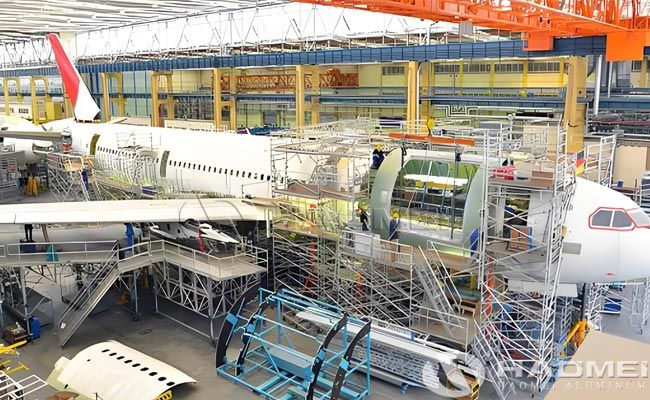
![]() Home > News
Home > News
Source:https://www.aircraft-aluminium.com/a/aluminum-7475-vs-7075-in-aerospace-industry.html
Aluminum alloys 7475 and 7075 are both very important materials in the aerospace industry. The comparison between aluminum 7475 and 7075 are mainly reflected in chemical composition, mechanical properties, processing technology, corrosion resistance and application scenarios.

1. Chemical composition difference
- 7075 aluminum belongs to the Al-Zn-Mg-Cu alloy system. The main alloying elements are zinc (5.1-6.1%), magnesium (2.1-2.9%) and copper (1.2-2.0%), and contains a small amount of chromium (0.18-0.28%). Its impurity content is relatively high, silicon ≤0.4%, iron ≤0.5%.
- 7475 aluminum also belongs to the Al-Zn-Mg-Cu system, but the impurity content is reduced by optimizing the composition, silicon ≤0.10%, iron ≤0.12%, while the zinc content is slightly higher (5.2-6.2%), the magnesium content is slightly lower (1.9-2.6%), and the copper content is similar (1.2-1.9%). This adjustment makes it purer, which helps to improve toughness and comprehensive performance.
2. Comparison of mechanical properties
- Strength and hardness:
The tensile strength of aluminum 7075-T6 is about 530MPa, the yield strength is 470MPa, and the hardness is 150HB. The tensile strength of aluminum 7475-T651 can reach 572MPa, the yield strength is 503MPa, the hardness is 160HB, the elongation is 11%, and the overall strength is slightly higher than 7075.
Although the yield strength of aluminum 7475 t7351 is slightly lower than that of aluminum 7075-T651, it has better plasticity, significantly improved fracture toughness, and better fatigue resistance.
- Fatigue and fracture toughness:
Due to the low impurity content and finer grains, the fatigue crack growth rate of aluminum 7475 is lower than that of aluminum 7075. Especially in the T7351 temper, its fatigue resistance is significantly better than that of 7075-T651, which is suitable for parts subjected to cyclic loads (such as wing skeletons).
- Low temperature performance:
Both maintain high strength at low temperatures, but aircraft aluminum 7475 has better low temperature toughness and is suitable for applications in extreme environments.
3. Processing and heat treatment
- Processing difficulty:
7075 has good processing performance and is easy to cut and forge, but its weldability is poor, and special processes (such as friction stir welding) and post-weld treatment are required.
Due to the high strength and high purity requirements, 7475 is slightly more difficult to process and requires the use of carbide tools, but precision processing can be achieved through optimized processes.
- Heat treatment:
Both require solution treatment (7075: 460-490℃; 7475: 460-490℃) and aging treatment (7075: T6/T73; 7475: T651/T7351). The heat treatment of aluminum 7475 requires more precise control to avoid damage to the aluminum cladding layer, and double-stage aging can improve stress corrosion resistance.
4. Corrosion resistance
- Aircraft aluminum 7075 has moderate corrosion resistance. The T73 temper can improve stress corrosion resistance, but it still needs aluminum or coating protection.
- 7475 aluminum has better corrosion resistance due to less impurities and optimized composition, especially in the T7351 temper, the resistance to stress corrosion and exfoliation corrosion is significantly enhanced, suitable for parts exposed to harsh environments for a long time (such as fuselage skin).
5. Cost and production
- 7075 aluminum has a mature production process and low cost, and is widely used in cost-sensitive structural parts.
- 7475 aluminum has a high cost due to high purity requirements and complex production processes (such as vacuum melting), and is mainly used for key parts with demanding performance requirements.
6. Aerospace applications
Typical applications of 7075:
- Fuselage structure: wings, trusses, bulkheads, etc.
- Landing gear components: load-bearing structures with high strength requirements.
- Early aircraft: such as Boeing 747 and B-29 bombers.
Typical applications of 7475:
- High-toughness components: wing skeletons, fuselage stringers, which need to balance strength and fatigue resistance.
- Modern aircraft: Boeing 777 fuselage structure, key components of ARJ21.
- Special scenarios: cryogenic containers, structural parts in highly corrosive environments.
In the aerospace industry, 7075 and 7475 aluminum alloys each have their own advantages. Aluminum 7075 is widely used due to its extremely high strength and relatively low cost, while aluminum 7475 performs better when higher strength and corrosion resistance are required. With the development of aerospace technology, 7475 aluminum has gradually replaced 7075 aluminum in high-end applications due to its comprehensive performance advantages, especially under the requirements of lightweight and long-life design, its high purity and optimized composition characteristics are becoming more and more important.